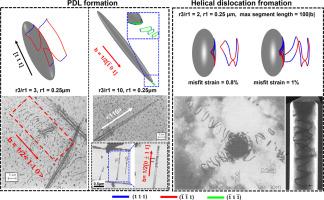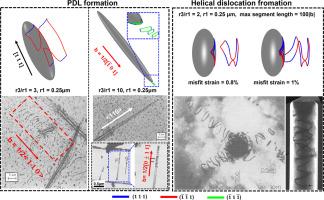Prismatic dislocation loop and helical dislocation generation from ellipsoidal inclusion in inhomogeneous materials: A comprehensive discrete dislocation dynamics simulation
IF 12.8
1区 材料科学
Q1 ENGINEERING, MECHANICAL
引用次数: 0
Abstract
Thermal mismatch in inhomogeneous materials can be alleviated by the formation of prismatic dislocation loops (PDLs). While previous studies focused on PDL generation from spherical inclusions, mechanisms for PDL generation from non-spherical inclusions remain unclear. To address this gap, this work employs discrete dislocation dynamics (DDD) simulations to systematically investigate PDL generation from ellipsoidal inclusions. Our results demonstrate PDL can be generated from the ellipsoidal inclusions with varying aspect ratios and orientations, even from non-rotationally symmetric regions. PDL generation from the fiber side and continuous generation from the fiber tip match experimental observations well. We have refined the mechanism of helical dislocation formation that larger inclusion size weakens the attraction between opposite screw dislocations, and higher misfit strain increases the difference in resolved Peach-Koehler force on relevant slip planes due to inclusion, both of which suppress pinch-off process. We identify the acceleration mechanism for atom transfer that when demands for atom transfer rise due to larger ideal PDL size or higher misfit strain, helical dislocations tend to form, accelerating atom transfer. These findings align well with experiments and simulations in the literature. This study advances the understanding of dislocation behavior and stress state near non-spherical inclusions, offering guidance for designing inhomogeneous materials with superior mechanical properties.


非均匀材料中椭球夹杂产生的棱柱位错环和螺旋位错:一个全面的离散位错动力学模拟
非均匀材料中的热失配可以通过形成棱柱位错环(pdl)来缓解。以往的研究主要集中在球形包裹体生成PDL,而非球形包裹体生成PDL的机制尚不清楚。为了解决这一差距,本工作采用离散位错动力学(DDD)模拟来系统地研究椭球体夹杂产生PDL。我们的研究结果表明,PDL可以从具有不同纵横比和取向的椭球体包裹体中产生,甚至可以从非旋转对称区域产生。从光纤侧面产生的PDL和从光纤尖端连续产生的PDL与实验结果吻合较好。细化了螺旋位错形成的机制,即较大的夹杂物尺寸削弱了相对螺位错之间的吸引力,较大的错配应变增大了相关滑移面上因夹杂物而产生的分解Peach-Koehler力的差异,两者都抑制了夹断过程。我们确定了原子转移的加速机制,当理想PDL尺寸较大或错配应变较大导致原子转移需求增加时,倾向于形成螺旋位错,加速原子转移。这些发现与文献中的实验和模拟相吻合。该研究促进了对非球形夹杂附近的位错行为和应力状态的理解,为设计具有优异力学性能的非均匀材料提供了指导。
本文章由计算机程序翻译,如有差异,请以英文原文为准。
求助全文
约1分钟内获得全文
求助全文
来源期刊

International Journal of Plasticity
工程技术-材料科学:综合
CiteScore
15.30
自引率
26.50%
发文量
256
审稿时长
46 days
期刊介绍:
International Journal of Plasticity aims to present original research encompassing all facets of plastic deformation, damage, and fracture behavior in both isotropic and anisotropic solids. This includes exploring the thermodynamics of plasticity and fracture, continuum theory, and macroscopic as well as microscopic phenomena.
Topics of interest span the plastic behavior of single crystals and polycrystalline metals, ceramics, rocks, soils, composites, nanocrystalline and microelectronics materials, shape memory alloys, ferroelectric ceramics, thin films, and polymers. Additionally, the journal covers plasticity aspects of failure and fracture mechanics. Contributions involving significant experimental, numerical, or theoretical advancements that enhance the understanding of the plastic behavior of solids are particularly valued. Papers addressing the modeling of finite nonlinear elastic deformation, bearing similarities to the modeling of plastic deformation, are also welcomed.
 求助内容:
求助内容: 应助结果提醒方式:
应助结果提醒方式:


